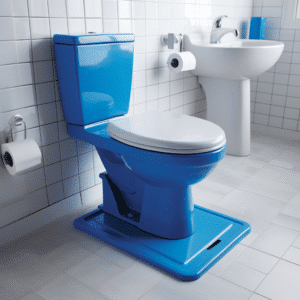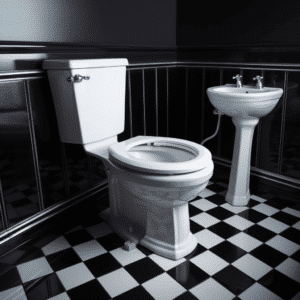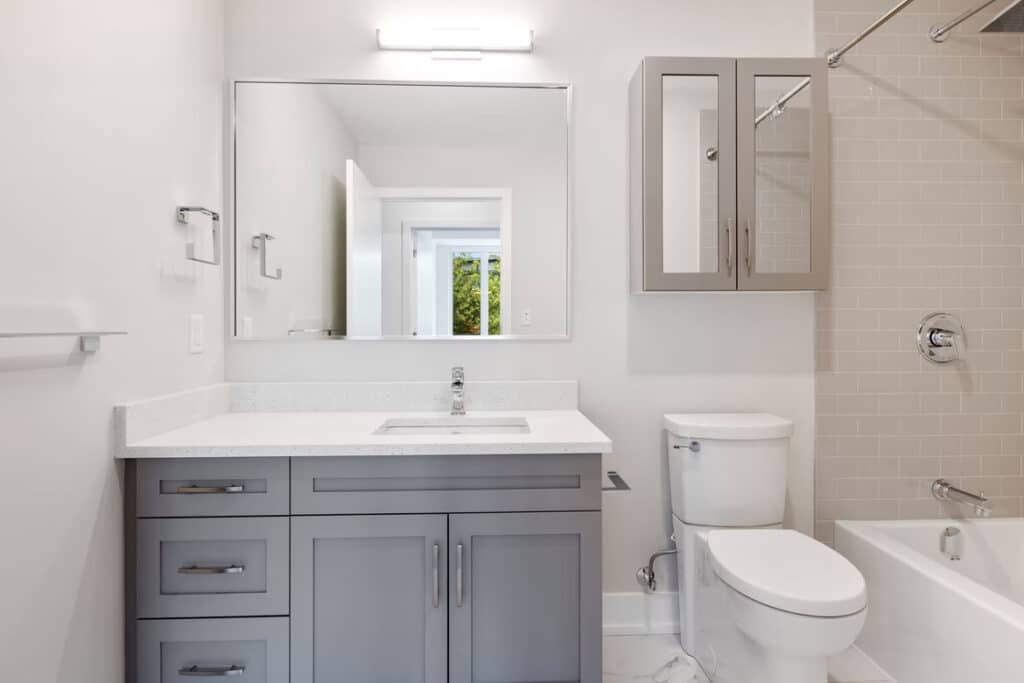Toilet falls through floor, Freak accidents are something most homeowners hardly think about. However, one specific mishap that seems to end up in movie scenes is the idea of a toilet falling through the floor.
Obviously, having a toilet falling through the floor is certainly not an ideal situation. But if your bathroom flooring has had better days, this thought may have crossed your mind.
Even so, it seems very unlikely. So can a toilet fall through the floor? Well, before we get to that, let’s address this one question first:
Table of Contents
How is a Toilet Secured to the Floor?

In most cases, there’s a large circular piece called a toilet flange. It connects the toilet to the floor and a drain pipe. This secures the toilet in place, using bolts to keep it secure. With time, this flange may start loosening, which can be a significant cause of toilet leaks.
Considering the nature of toilets, repeated use may cause the bolts holding the flange to the floor to loosen over time.
Can a Toilet Fall Through The Floor?
Well, it turns out that the answer is yes. Given the right circumstances, a toilet can fall through the floor. Just like anything else, toilets can succumb to gravity and give out if the floor underneath is weak or unable to support its weight. In fact, this would happen to any fixture in the bathroom.
Fortunately, builders have strict standards for constructing bathrooms making such issues very unlikely. However, if you notice a leak or a water stain on your ceiling, be sure to have it checked out. Fixing the leak while it’s small can prevent you from having it all ripped out and replace the entire flooring later on.
Possible Reasons for a Toilet Falling Through the Floor
If you’re concerned that your toilet may fall through the floor, it’s probably because you’ve noticed some changes to your bathroom. If you have noticed that your floor is getting soft or sagging, you may have more serious issues going on underneath.
First, if the flooring is damaged or weak, it is possible for a toilet to fall through it. So, if you realize that there is some floor softness on your bathroom floor, or notice some leaks, be sure to check that the flooring and sub-flooring are solid.
Builders will most likely have specific quality controls in place to ensure this doesn’t happen. This includes inspections being carried out all over the property, checking for whether or not this could actually happen.
There are a lot of signs that your bathroom floor is not going to support the weight of the toilet. So we gathered some common questions and answers to help keep you and your property safe from falling toilets.
How Secure is Your Toilet to the Floor?
To avoid the wax seal being damaged by side-to-side movement, toilets should be caulked to the flooring to prevent overflows or splashes from puddling under the toilet and rotting the floor. Set the toilet and then run a thin bead of caulk around the outside edge of the bowl; it is a common DIY technique.
The floor around your toilet can get wet if the wax seal has failed. This, in turn, causes water to accumulate around the toilet’s base. However, the problem is not always in the wax itself. You can try to remove the water from the floor and dry the toilet.
Again, you can tell your toilet is leaking by checking closely the flooring underneath it. For instance, if your bathroom flooring is getting soft or when there’s mold festering around the sides of the toilet, then you may have a leak issue.
Additionally, if you realize that there’s some excess water in your bathroom, or if you notice an increase in moldy or musty smells, this could mean you have a more serious problem. Leaking toilets are a major cause of most bathroom issues and can ultimately lead to your toilet falling through the floor.
How to Know If Your Bathroom Floor is Rotting

It is possible to know whether your bathroom floor is rotting. Some of the most common signs include mildew, foul odors, and wet or sagging floors. These signs may mean it is time to have it checked to determine what exactly is going on beneath the surface.
A leaking toilet or wobbling lead can flood the bathroom floor, which can be even worse of the toilet is loose. This can lead to mold and mildew issues, as well as rotted wood. That means leaving a leak unattended can cause a costly repair or replacement of the floor. Make sure you call a plumber if you notice your toilet is wobbling.
To know if your bathroom has water damage, pay attention to the walls and floors. If you notice any buckling or wrapping to the walls or the floor, water damage is likely taking place beneath the surface.
You should also keep an eye on any visible mold or mildew as this is another significant sign pointing to water damage. Besides, even before you can see the mold or mildew, you may be able to smell it. So if something tells you the surface is off, check for water leaks.
Does Subfloor Go Under Toilet Flange?
The toilet flange should be installed on top of the finished floor. That means the flange’s bottom edge should remain parallel to the base of the toilet. Therefore, if the toilet is on top of the tile, the flange should be on top of the tile as well.
Vinyl flooring, for instance, does not necessitate an underlayment and can be laid directly on top of the subfloor. Carpet, laminate, and tile all need an extra underlayment as a middle layer.
In the event that there’s the need to replace the subfloor, the damaged area of the floor must be completely removed before installing a new one. As such, all floor covering and underlayment materials must be removed from the damaged area. The fixation method may differ depending on the type and condition of the flooring you have.


